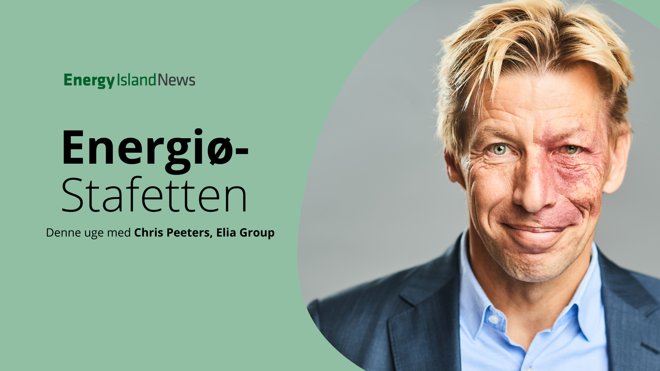The Energy Island Interview Series: Chris Peeters, managing director of Elia Group (Belgium)
My name is Chris Peeters, CEO of Elia Group. In recent years, our Group has changed from being a traditional utility company into an international player.
Through our subsidiaries in Belgium (Elia) and the north and east of Germany (50Hertz), we have built up considerable expertise through early development projects in both the Belgian North Sea and the German Baltic Sea, in alternating and direct current.
Along with our Danish colleagues at Energinet, we have built the world’s first hybrid interconnector. Last year, we launched WindGrid, a new subsidiary which will continue to expand the Group’s overseas activities, contributing to the development of offshore electricity grids in Europe and beyond.
Why do you support the concept of enery islands?
Offshore technology is becoming more and more efficient. Several political summits like the one in Esbjerg have already highlighted the importance of offshore wind development for strengthening our energy security.
The consequence is that the grid needs to be adjusted in line with this new reality. We have to find ways to accelerate our infrastructure build-out. Moreover, it’s not only about integrating more wind farms, it’s also about building interconnectors. Renewable energy sources (RES) are unevenly distributed. To optimise and share the European RES potential, we need more interconnectors and more international cooperation.
Why does Belgium need an energy island?
The Princess Elisabeth Island will allow us to harvest the full potential of renewables in the modest space available in our waters. Our energy Island will be located 45 km off the Belgian coast and will serve as the link between the offshore wind farms in the second Belgian offshore wind zone (3.5 GW) and Elia’s onshore high-voltage grid. The Belgian energy island will also serve as a central hub for new interconnectors with the UK (Nautilus) and Denmark (Triton Link).
What is the link between the Belgium energy island and the Triton interconnector with Denmark?
Thanks to the Triton link with Denmark, Belgium will be interconnected with a country that is not a direct neighbor. This will gives us access to the wider North Sea. The potential for RES is unevenly distributed across Europe. In order to share this potential, interconnectors are needed between countries that have an excess in RES and those that have an RES deficit. Belgium is a country that is densely populated with highly energy intensive industry. The most optimal way to provide security of supply and affordable energy to our citizens and industry is to collaborate with countries that have a more favorable supply-demand balance, such as Denmark. In that perspective, Triton and the Belgian energy island will play a major role to preserve welfare in our country but also to contribute to other countries to connecting our hubs together.
Right now, in what stage is Princess Elisabeth Island?
The permitting process for the energy island is currently underway. Once all permits have been approved, work on constructing the island is due to begin in 2024 and will last two years. The construction of the high-voltage infrastructure on the island and export cables leading to the mainland will then begin in mid-2026. In the meantime, offshore wind farm developers will start building their wind farms in the Princess Elizabeth Zone. The connection of these wind farms to Elia’s onshore grid is linked to the commissioning of two projects which aim to reinforce Belgium’s electricity backbone. Elia is aiming to have the full capacity of the new offshore wind farms connected to its grid by 2030.The interconnectors will be connected at a later stage.
What will the Belgian Energy Island look like, and which technologies will be deployed (Power-to-X, datahub ao.?
The Princes Elisabeth Island will be an innovative tour de force that will combine both direct current (HVDC) and alternating current (HVAC). The island’s high-voltage infrastructure will bundle the wind farm export cables from the Princess Elisabeth zone together, while also serving as a hub for future interconnectors. These will be hybrid interconnectors that have a dual function and will therefore be more efficient. They will ensure the exchange of electricity between countries and will also be connected to gigantic offshore wind farms in the North Sea that will provide our country with large volumes of renewable energy. The area occupied by the energy island on the seabed will stretch up to 25 hectares maximum (equivalent to 37.5 football pitches).
How is the general Belgian public opinion towards TritonLink and Princess Elisabeth Island?
Belgium, along with Denmark, the Netherlands, Germany and the United Kingdom, is a leader in offshore wind energy. And now we are taking a new step by developing the first building blocks of an integrated European offshore grid. There is a lot of enthusiasm about this project; both among the authorities and the public. The fact that Elia Group is involved in the development of both Danish islands makes our cooperation with Energinet unique. We have jointly built the first hybrid interconnector together, now we can also connect the first energy islands.
What will be the biggest challenge(s) for the Belgian Energy Island to be successful?
There are many areas where innovation is still needed, and we strongly believe that working towards these with the entire value chain will create a win-win situation. It is is a very complex project that needs to be realised in a challenging environment on time, on budget and with the expected reliability.
How can Princess Elisabeth Island be built faster than the Danish Energy Islands (DK’s Baltic Sea Energy Island is expected in 2030 and the Danish North Sea Energy Island later in 2033)?
(joking!) Like Thomas Egebo thinks that Carlsberg isprobably the best beer in the world, the Danish might think they probably have the world’s first energy island. But this is not about taking home the cup. Building energy island is not a competition. This is about how both Belgian and Denmark can jointly create the infrastructure that is needed for the protection of our climate and our welfare. And of course we cannot compare both projects as the conditions are very different. Our island is a pure transmission island while the Danish island is a multipurpose island. Our ownership structure is therefore less complex. And it has to go fast as Belgium has urgent needs to connect some additional wind farms in the very short term.
Artiklen er en del af temaet Energiøer.










